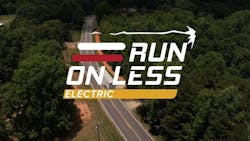For those who have been sitting on the fence when it comes to electric trucks, I want to tell you that, for many of you, it's time to go for it.
Run on Less-Electric (RoL-E), which took place last fall, showed us that for certain applications electric vehicles are a viable option—right now. To be clear, today’s EVs will not work in every application, but RoL-E proved that in four specific market segments they are working. We had 13 fleets prove that.
Here are the applications where we think electric trucks work—and work well:
- Vans and step vans: These Classes 3 to 6 vehicles in urban delivery cycles usually do not have issues with vehicle tare weight impacting freight weight. Range also generally is not a concern because these vehicles travel less than 100 miles a day. Urban traffic and street driving also permit energy recovery through regenerative braking systems. Charging times are not that demanding as these vehicles operate in one-shift operations with long overnight dwell times. We think this market segment is 100% electrifiable.
- Medium-duty box trucks: These Class 6 trucks tend to cube out before they weigh out, and range generally is not a concern with trucks driving less than 100 miles per day. Charging times are not that demanding as these vehicles operate in one-shift operations with long overnight dwell times. A challenge to overcome is higher body electric demands such as refrigeration. We think this market segment is 100% electrifiable.
- Terminal tractors: Terminal operations tend to be demanding with short dwell times when drivers take breaks and often slip seating for multi-shift operations. These vehicles accumulate a surprising number of daily miles considering they rarely if ever leave their facilities. Also, they are always at a depot, so they're always near charging facilities. Weight generally is not an issue. Terminal driving is very stop-and-go, which is appealing to the acceleration and regenerative braking advantages of the electric drivetrain. Range and payload are not issues as long as drivers make use of opportunity charging. We think this market segment is 100% electrifiable.
- Short regional haul heavy-duty tractors: Heavy-duty day cab regional haul is more challenging for electric vehicles because their duty cycles are more sensitive to range and payload weight variations. Where the trip distance is short, and/or operations have lengthy delivery dwell times, CBEVs can adequately handle the entirety of one-shift operations. Payload weight also factors into capability to accomplish a day’s work for the truck. We think this market segment is 70% electrifiable.
If you are operating in any of these duty cycles, check out our first report on RoL-E, "Electric Trucks Have Arrived: Documenting A Real-World Electric Trucking Demonstration." I’d also love to hear about your experience with electric vehicles in these market segments. Email at [email protected].
About the Author

Michael Roeth
Executive Director
Michael Roeth is the executive director of the North American Council for Freight Efficiency. He serves on the second National Academy of Sciences Committee on Technologies and Approaches for Reducing the Fuel Consumption of Medium and Heavy-Duty Vehicles and has held various positions with Navistar and Behr/Cummins.
